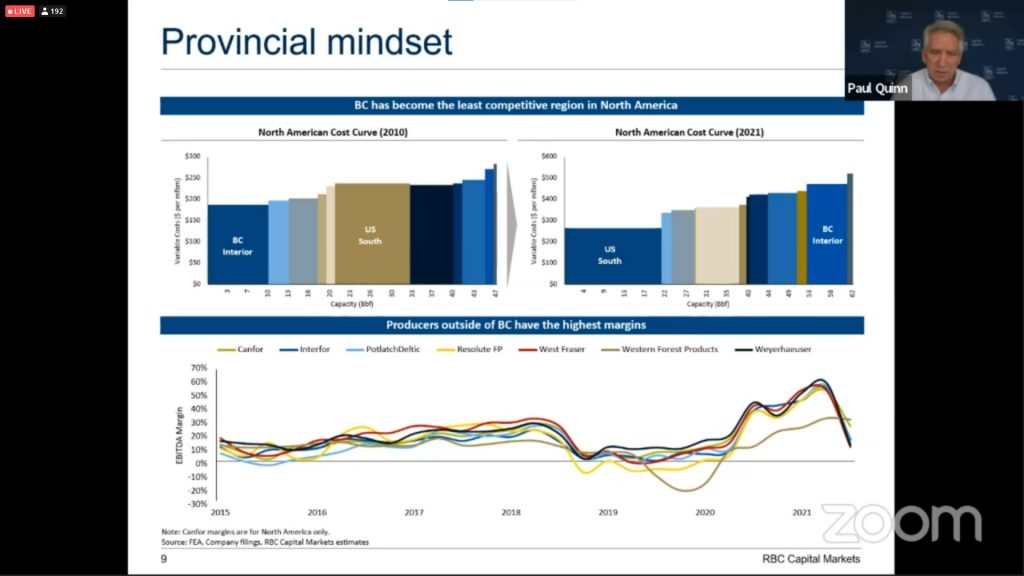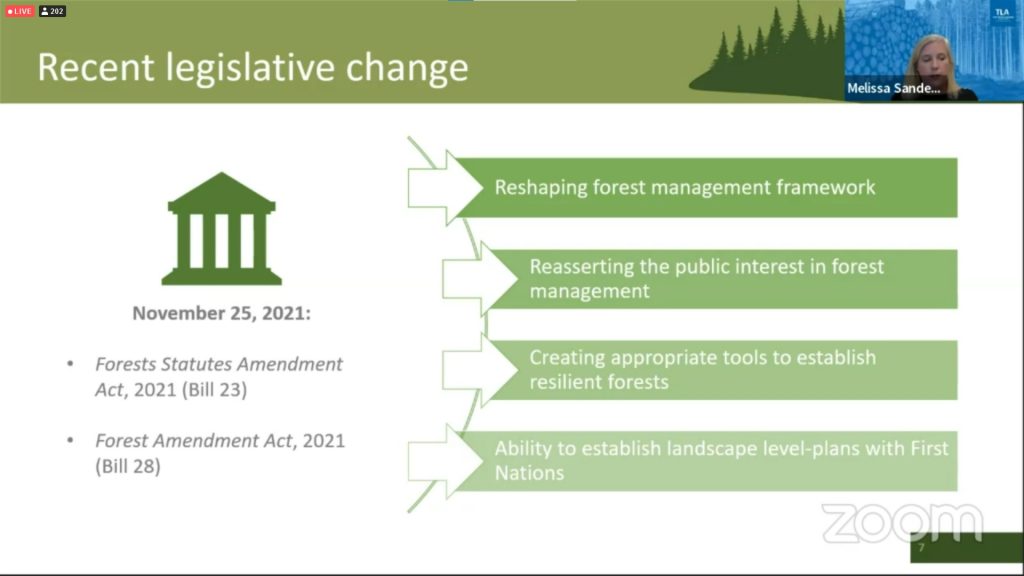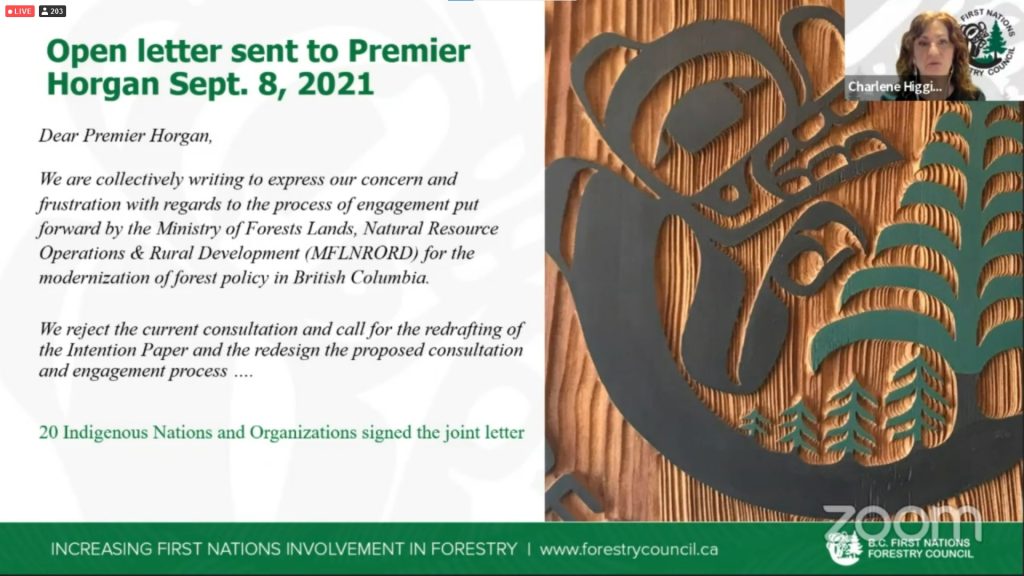
Features
TLA 2022: Fear, frustration and an uncertain way forward for BC’s forest industry
January 17, 2022 By Adam Kveton
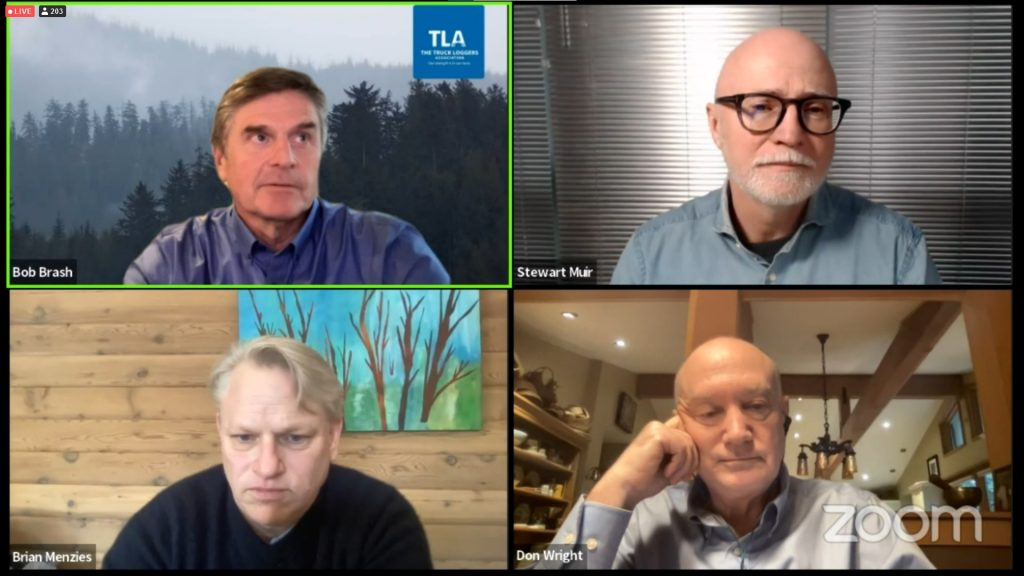 (Top L-R) TLA executive director Bob Brash, Stewart Muir, executive director of Resource Works Society, (bottom L-R) Brian Menzies, executive director of the Independent Wood Processors Association, and Don Wright, senior fellow at the Public Policy Forum. Zoom screenshot.
(Top L-R) TLA executive director Bob Brash, Stewart Muir, executive director of Resource Works Society, (bottom L-R) Brian Menzies, executive director of the Independent Wood Processors Association, and Don Wright, senior fellow at the Public Policy Forum. Zoom screenshot. “…B.C. is becoming uninvestable.”
“…a failed engagement process.”
“…I’m potentially scared.”
“…a growing sense that B.C. doesn’t need the resource industries anymore.”
“Everyone on this call should be afraid…”
This year’s Truck Loggers Association (TLA) conference, like every year, was not short on energy or passion. But frustration, anger, and grave concern were also voiced by many forest industry experts who presented during the virtual conference last week.
However, it’s Garry Merkel of the Old-growth Review Panel who may have best described the gauntlet that’s been thrown down at the feet of B.C.’s forest industry:
“It’s not the strongest people who survive or the species. It’s the ones who are most able to adapt and to change with changing circumstances. And we are definitely in a world of change right now.”
Who or what is to blame for those changing circumstances appeared to be on many peoples’ minds.
The TLA’s executive director, Bob Brash, opened the conference, saying, “The discussions over the next couple days reflect our best attempt at trying to start the process, along with government, toward a collective strategy that British Columbians can support towards moving our sector forwards, and not backwards,” he said.
In the view of various presenters at the conference, this is precisely the thing the B.C. government has so far failed to do.
And although Assistant Deputy Forests Minister David Muter noted that old-growth deferrals are currently temporary as the government works to engage with stakeholders, other presenters provided both evidence and predictions that this temporary action has and will cause significant industry losses.
However, the conference’s first presenter was able to kick things off with some good news.
Economic outlook
Russ Taylor with Russ Taylor Global opened the B.C.’s Market and Investment Climate session saying that the outlook for the North American market is very good.
“I’m very confident we still have three or four years of strong lumber consumption ahead of us. So 2022 should be another good year,” he said.
While repair and remodelling were major trends this past year, Taylor pointed to a low housing building trend that wasn’t keeping up with demand in the U.S. He said he expects housing builds to trend upwards. And since spiking and crashing, repair and remodelling is once again gaining steam.

Russ Taylor with Russ Taylor Global shares U.S. housing starts data during the 2022 TLA virtual convention.
Also, softwood lumber imports to the U.S. has Canada accounting for about 86 per cent. “Canada dominates,” said Taylor.
Unfortunately, Canada is not poised to take advantage of the demand, he said. With B.C. production slowing in recent years and predicted to be further reduced with the B.C. government’s recent policy decisions, it’s the U.S. South that Taylor points to as taking advantage of this steady demand.
Ignoring 2022, he says there is about 1.3 billion board feet a year of new capacity in the U.S. South, but that production is only increasing at about half that. He says that is likely due to new mills having to ramp up, weather issues, COVID-19, etc. So, despite those new mills, U.S. production will not meet demand for a while.
He predicts a tight supply situation going forward, more imports, and fewer exports. Though he expects U.S. production to begin really ramping up in 2023.
As for the government’s recent policy changes and old-growth deferrals (2.6 million hectares temporarily), Taylor said the government’s actions are hurting the value-added sector, even though the government is pinning its hopes on that very sector. Old-growth deferrals will hurt these manufacturers in particular, he said, while U.S. value-added companies will continue to have greater access to capital and an overall advantage.
He predicted more mill closures will take place because of the old-growth set-asides, and that “B.C. is not exactly the right place to invest. Unless you’re here – that’s different.”
Paul Quinn of RBC Capital Markets took it one step further, saying, “B.C. is becoming uninvestable.”
He began his presentation by asking, “How does one significantly change or reduce the industry?” and proceeded to show the B.C. government’s recent decisions as examples of how to do that.
He noted the B.C. forest industry’s transition to the high-cost producer in Canada, and characterized the government’s intention to increase forest sector participation as, “take[ing] tenure from the most efficient firms and redistribute[ing] it to less efficient players.”
Continuing to respond to the B.C. Government’s intentions paper from June 2021 as well as bills 23 and 28, Quinn described the government’s decision to increase government regulation over the industry as “transfer[ing] significant and almost unchecked control to the government.”
As for the projected job losses from the old-growth deferral, Quinn called Minister Katrine Conroy’s stated estimate of 4,500 jobs as an attempt to minimize the cost of the government’s changes. Quinn noted the B.C. Council of Forest Industries’ (COFI) estimate of 18,000 job losses and up to 20 mill closures as well as other estimates in the range of 12,000 to 10,000 jobs lost.
“It’s definitely going to be multiples of the minister’s estimate, and I think we should be straight up and frank about that.”
This is all resulting in B.C. companies investing outside of Canada, or even elsewhere in Canada.
Overall, Quinn said he agrees with the government’s stated goal of increasing First Nations’ participation in the forestry sector and suggested a full move to revenue sharing with First Nations should happen sooner rather than later. He agreed that more old-growth should be protected in B.C., but disagreed on the government’s assessment of how much old-growth is currently protected. And he encouraged government to apply the concept of sustainability not just to environmental matters, but to businesses that sustain communities and feed families as well.
“Let’s deal with these changes – whatever they become – in a timely and fair manner,” said Quinn, as taking years to compensate those holding tenure on deferred old-growth forests will only raise uncertainty and costs in B.C.’s forest sector.
Missteps and next steps
The next presentation, entitled Modernizing Forest Policy in BC: Perspectives, had the conference’s first government representative: Assistant Deputy Forests Minister Melissa Sanderson.
Sanderson began by addressing the cause of the changing circumstances that B.C.’s forest industry finds itself in – forests are threatened, policies from decades ago are not working, and change is needed, she said.
The government’s focus is on taking meaningful action on reconciliation with First Nations and increasing the sustainability and stewardship of forests while staying competitive on a global stage and getting fair returns on assets for British Columbians, she said.
Sanderson noted that the government’s new policies have been greatly informed by public engagements cross the province, and working closely with First Nations, the forest sector and communities (though representatives of the latter two groups would disagree with that assessment later in the conference).
She admitted that COVID-19 and natural disasters this past year, from wildfires to floods, made engagement difficult. But Sanderson pushed the government’s intentions on improving the dispute process between tenure holders and contractors, working towards alignment with the UN Declaration on the Rights of Indigenous Peoples Act (UNDRIP, passed into law in B.C. in 2019), the new tenure redistribution tool to create a more diverse forest sector, minimizing the burning of slash piles and more.
Sanderson further noted that the release of the government’s intentions paper was “simply the continuation of an ongoing dialogue,” and that the engagement process will continue, in particular with First Nations, industry experts and stakeholders.
However, the CEO of the B.C. First Nations Forestry Council, Charlene Higgins, characterized the government’s work with First Nations so far on this issue as a “failed engagement process”. She said that giving First Nations a narrow window to comment on the government’s research and vision for the industry, all of which had been done internally, is not the collaborative approach that is needed.
“Really, Nations are frustrated. And the frustrations are growing.”
Higgins described how letters were sent to First Nations, inviting them to a public engagement process taking place in August when communities were reeling from wildfires (some of which were evacuated), cultural hunting and gathering practices were taking place, and First Nations communities were dealing with the trauma of the discovery of unmarked graves near residential school sites.
“Many nations didn’t attend these virtual sessions … and the bottom line is that many of the Nations just don’t have the technical capacity, and they didn’t have the resources to really participate in an informed and meaningful manner on being able to understand the policy changes that were being proposed.”
Higgins lamented that the government did not include the B.C. First Nations Forestry Council in the process to help the Ministry engage with First Nations, though the Council had offered to participate.
Twenty First Nations and Indigenous organizations signed an open letter to Premier John Horgan saying they reject the consultation process taking place, and called for a re-drafting of the intentions paper and a re-design of the consultation process.
“Unfortunately, the letter was ignored,” said Higgins.
A further letter from government claimed that it had heard back from 125 First Nations, and that it was working in co-operation with Indigenous Nations. “But we don’t know who you are talking to. Nations don’t understand who [government is] talking to, and because they are not working with the Forestry Council, we don’t know who really is having meaningful input into this,” she said.
First Nations in contact with Higgins have described the process as “disrespectful, it’s compressed, it’s flawed,” and called for “an immediate recess,” she says.
Higgins went on to say that, while the Forestry Council is in support of tenure reform and re-allocation, she said the policy changes being made are not the substantial changes needed to align B.C. with UNDRIP.
COFI president and CEO Susan Yurkovich focused on reminding folks of the special place the forest industry holds in B.C.
“This is an industry … that is foundational to the province,” she said. She claimed B.C.’s economic growth out of COVID-19 is as strong as it is thanks to the resources sector, and led by the forest sector.
“This is a sector that feeds a lot of families across our province. It’s one in 25 jobs, 100,000 jobs that are supported, one in five of the manufacturing jobs. These are high-paying jobs, and importantly, about 5,300 Indigenous Nation members are part of our direct work forces. That’s about nine per cent of our direct workforce and growing,” said Yurkovich.
Referencing the previous presentations by Taylor and Quinn who noted that investment is going elsewhere, Yurkovich countered that $14 billion was spent in B.C. on equipment, forestry operations and more between 2009 and 2019.
She noted that B.C. forest products store carbon and are recognized globally as helping fight against climate change. “We are already a conservation leader. It doesn’t mean we can’t do more.”
As for the government’s recent changes, Yurkovich called for establishing an agreed-upon set of facts grounded in science and traditional knowledge, a meaningful seat at the table for all those involved, including First Nations and industry, and a predictable, clear and efficient process for moving forward.
In response to a question on why the government’s independent technical panel was composed of 80 per cent Sierra Club folks, and no forest industry members (a characterization that the government does not agree with), Yurkovich said:
“In our world … people go to poles very quickly, and I think we really actually need to have these challenging conversations with different views around the table. And it’s hard, and it has to be done in a respectful way. But I really do believe, if we are going to find durable solutions to complex problems.
“… if we are going to ensure we have a vibrant, sustainably healthy forest, we actually need to be working collaboratively.”
Government’s reasoning
Day 2 of the conference began with Solutions for Old-growth and the Working Forest, beginning with a presentation from Assistant Deputy Minister David Muter.
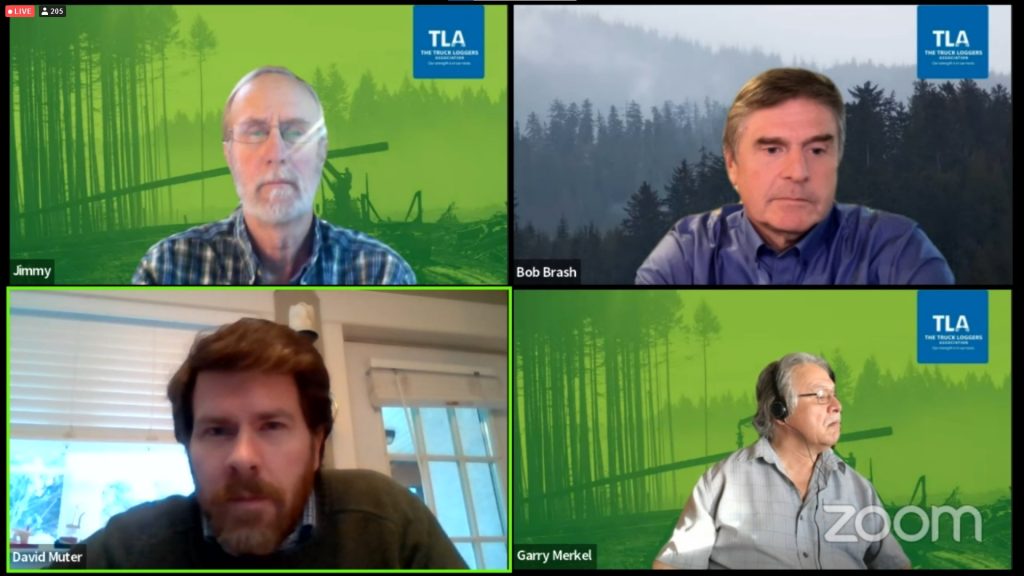
(Top L-R) Jim Girvan, industry analyst with MDT Ltd., Bob Brash, TLA executive director, (bottom L-R) Assistant Deputy Minister David Muter, and Garry Merkel of the Old-growth Review Panel, answer questions during the TLA 2020 virtual convention.
He said part of the government’s reasoning behind the old-growth deferrals was an “overwhelming consistent response from the people they met with and spoke with that something needs to change.” This opinion, he said, comes from a “fairly comprehensive engagement” across communities, First Nations, industry and other stakeholders. That engagement was led by Al Gorley and Garry Merkel, with the latter presenting next.
Another reason for the deferrals, Muter said, is based in environmental need. “There are areas in the province, and this isn’t really news, where failure to act right away can lead to an irreversible loss of biodiversity.”
“And we know this. We’ve done some analysis on this,” he said, later noting that this “irreversible loss” was in fact a loss that could take hundreds of years and the right circumstances to regain.
Muter went on to explain that the 2.6 million hectares of old-growth being deferred is subject to discussions with First Nations on whether or not they agree. So far, the majority of First Nations have been engaged in discussions with the government, he said, while others have not responded, but the government knows why and will have these discussions, he said.
So far, responses have ranged. Some Nations feel that the existing management of old-growth is adequate and there is not a need for deferrals. Others need more time to do analysis (Muter said the government is supporting and providing time for that), and others have agreed that a temporary pause on old-growth is needed.
“If a Nation comes forward and indicates an interest in a deferral, we are going to make sure that there is that discussion with industry … to explain the interest that the First Nations and government has, and discuss with them how best to implement and address that,” Muter said.
Muter also acknowledged that, while government is aware that there will be impacts on jobs from these deferrals, the 4,500 number is just a preliminary estimate, and that further analysis on the impact will be done.
Next to present was Merkel, a co-chair of the Old-growth Review Panel whose report contained 14 recommendations, all of which were adopted in their entirety by the provincial cabinet.
Merkel presented the government’s moves on old-growth and in various other arenas as, at least in part, an attempt to stabilize the four-year cycle of changing political interest and policy that makes industries like forestry unstable. “We are trying to manage thousands of year-old landscapes on a four-year political cycle, and it’s causing us lots of grief in all sectors.”
Another emphasis in these changes is moving to a system that focuses on ecosystem health.
“We have been taught as foresters to think ‘trees’, not ‘ecosystems,’ and we adopted a policy back in the early ’40s …that we were going to convert all of our timber harvesting land base to managed, second-growth forest,” said Merkel.
However, it’s the oldest parts of an ecosystem that allow for continued biodiversity, and support resiliency, he explained. Once you get down to 30 per cent of original forest in an ecosystem, that’s when risks become high, and major species are lost, he said. Merkel called out the loss of moose and caribou in particular in B.C.
“The deferrals are intended to hang on to that last little bit, these areas that are less than 10 per cent, the critical areas, so that we can have some room to actually plan for and think about … ‘How do we keep these ecosystems healthy so that they can provide the range of things [that we need] as a province,” he said.
Merkel finished by saying that these are transformative changes that will be difficult, but that they are aimed at getting the province to a much more positive future.
A far different presentation was made by Jim Girvan, a career forestry professional, industry analyst, and owner of MDT Ltd. He began saying that he would not be discussing the validity of the government’s decision, but would instead enumerate the various winners and losers due to the government’s policy changes, as he saw them.
He noted that an interior pellet plant and a coastal paper mill have closed, which he attributed to these government changes, and predicted 10 more sawmill closures, mostly ones that need large logs.
He called the B.C. forest industry, carbon sequestration, secondary manufacturing, First Nations, rural communities as well as British Columbians as a whole losers due to the changes, while calling Minister of the Environment and Climate Change Strategy George Heyman, the Sierra Club, equipment resellers, the U.S. South and others winners.
“No one who supports a reduction in the use of natural resources in B.C. should ever again be able to complain about a lack of teachers, long hospital waits, a lack of doctors, or shortages of police in this province,” he said, tying the resource industries to B.C.’s standard of living. “If there is no money, these services simply cannot be paid for, and we are all going to be forced to live with a lower standard of living.”
He also called himself a loser in all this because his own hip surgery in Nanaimo was going to have to wait until August of this year.
Girvan noted that, despite the old-growth deferrals being temporary in nature, “the notion that something is temporary doesn’t necessarily, in my view, mean that the impacts will be eventual, because a lot of them have already happened, and we are going to continue to see them happen in the very short term.”
What’s next?
The conference’s final session began with Stewart Muir, executive director of Resource Works Society, pointing to a hybrid advocacy strategy of protests and large-scale lobbying as the cause for the B.C. forest industry’s current predicament.
He described how he felt the blockades and protests were part of a larger advocacy plan, providing images and misinformation to be shared around the world so that others can comment on “how terrible a place that British Columbia must be.”
He went on to discuss various organizations that he said have many lobbyists in the halls of government “swarming” government officials, and working to form government opinion on forestry. Muir noted he’s “not disputing the right that these people have to bombard decision-makers, but I think they are the only ones doing it, and that’s an issue.”
Muir said he would encourage B.C.’s forest industry to adopt these kinds of hybrid advocacy techniques, to push back on and correct incorrect information quickly, and to look for ways to be constructive change leaders.
Executive director of the Independent Wood Processors Association, Brian Menzies, confirmed that, despite the B.C. government saying they want to encourage the value-added sector, the old-growth deferrals are already hurting that sector.
These companies have little to no tenure themselves, and often get their dimensional lumber on the open market. Finding fibre is continually a make-or-break issue for these companies, and many require old-growth lumber as a core part of their production, Menzies said.
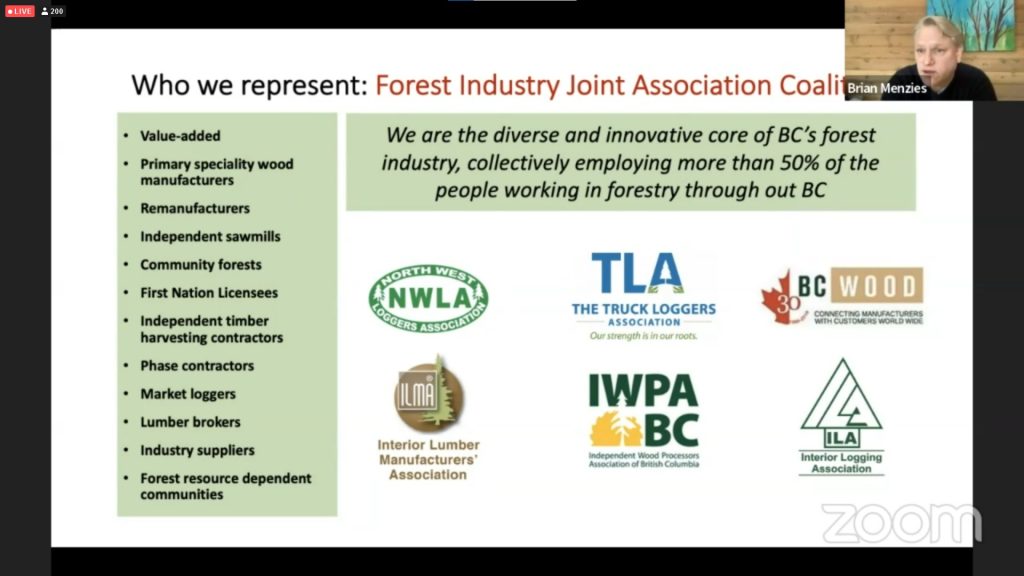
Executive director of the Independent Wood Processors Association, Brian Menzies, presents at TLA 2022.
He added that companies are already running out of inventory, and that if government wants to support them, a guaranteed supply of fibre is the way to do it.
As it stands, Menzies said it’s months before companies begin to shut down. While he said he’s in support of the government’s new focus on preserving ecosystems, he, like others, lamented the lack of industry representation in the groups that defined the science around the decisions the government has made.
In an effort to be heard, Menzies showed off a new ad in support of the forest industry (which can be viewed here), and a new website – ForestryForBC.ca.
Finishing out the conference was Don Wright, former deputy minister to Premier John Horgan, and now a senior fellow at the Public Policy Forum.
Wright’s take on why these changes have happened is because B.C.’s forest industry lost its social licence. “It has not effectively made the case that it is essential to B.C. prosperity,” he said.
Wright said the issues that have hurt the forest industry’s social licence include:
• not moving fast enough to develop First Nations partnerships;
• consolidation of large tenure-holding companies and their interest in investing outside of B.C.;
• population growth in urban areas where residents feel less of a connection to forestry;
• the industry’s inability to work together with communities and stakeholders; and
• the overall sense by a large portion of the public that the B.C. economy is doing fine and perhaps doesn’t need the resource industry.
He went on to describe how B.C.’s economy, in his view, is being temporarily buoyed by the housing market and that this will end sooner or later, that B.C. is living beyond its means, and that the natural resource industries will be best suited to provide prosperity going forward.
“You all need to push back on this very aggressively,” said Wright with regards to the idea floated by some that “so-called” green industries could replace the resource industries.
Bob Brash finished off the conference with a statement from the TLA, saying that, “The truth, re-affirmed over the last two days, is that we all know that critical old-growth should be protected. But having said that, B.C. will never run out of old-growth.”
He said wood remains the best solution to addressing climate change, that the TLA believes there are solutions that would not sacrifice so many jobs and businesses, and that the industry must be much more involved in these government decisions as it’s industry that will implement them in B.C.’s forests.
Print this page
